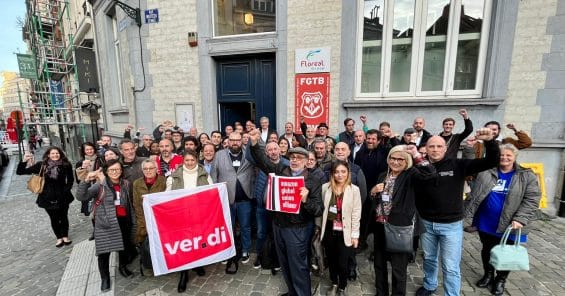UNI’s Global Amazon Alliance issues ‘Common Demands’ for an overheating planet
24.07.24
In a coordinated effort to combat the rising dangers of extreme heat in the workplace, the UNI Global Union Amazon Alliance, representing Amazon workers in over 20 countries, has unveiled a comprehensive set of demands aimed at ensuring safe working conditions for Amazon workers. This announcement follows a new report from the International Labour Organization (ILO) that highlights the increasing risks of heat stress for workers globally.
“As the climate crisis intensifies, workers at Amazon and around the world are increasingly bearing the brunt of extreme weather conditions in their workplaces. The demands we have outlined are not just about improving working conditions—they are about safeguarding lives,” said Christy Hoffman, General Secretary of UNI Global Union. “In our overheating planet, workers are being pushed to their physical limits, facing unprecedented risks to their health and safety. Amazon and other employers must recognize the urgent need for comprehensive measures to protect their employees. This is not just a matter of workers’ rights to a safe workplace; it is a matter of human rights and basic dignity. We call on Amazon to heed these demands and work with us to create a safer, more sustainable working environment for all.”
The ILO’s report, “Heat at Work: Implications for Safety and Health,” reveals alarming statistics: in 2020, 4,200 workers worldwide died due to heatwaves, and 231 million were exposed to extreme heat, marking a 66% increase from 2000. Moreover, the report emphasizes that nine out of ten workers experienced excessive heat outside of heatwaves, and eight in ten heat-related occupational injuries occurred under these conditions.
“This is a human rights issues, a workers’ rights issue, and an economic issue, and middle-income economies are bearing the biggest brunt. We need year-round heat action plans and legislation to protect workers, and stronger global collaboration among experts to harmonize heat stress assessments and interventions at work,” explained Manal Azzi, ILO’s Team Lead for Occupational Safety and Health.
More and more workers across the world are demanding changes to workplace rules govering where and how to work during heatwaves. Just last month in India, the Amazon India Workers Association (AIWA) called on the Ministry of Labour and Employment and the National Disaster Management Authority to implement immediate protections for warehouse workers. This comes after Northern and Western India experienced record-breaking temperatures, with Delhi hitting 49 degrees Celsius in May 2024, the highest since 1901.
“Our lives are on the line,” the Alliance states, highlighting the critical nature of their demands. “The time to act is now.”
The UNI Global Union Amazon Alliance has outlined several key demands to address these urgent safety concerns:
Common demands for safe working at Amazon during extreme heat
Amazon workers are on the frontline of the climate crisis. Amazon’s brutal productivity demands, anti-unionism and a workplace that is disproportionately more dangerous than comparable employers create unacceptable risks for Amazon employees working in extreme heat.
Around the world, Amazon’s brutal anti-unionism and unrealistic productivity quotas exacerbate an already difficult and dangerous job. Too often, workers fearful of losing their jobs are pushed too hard and too fast, putting their lives at risk.
But workers and their unions are fighting back. In facilities where workers have taken collective action, they have forced Amazon to install extra fans and cooling stations, ensure lower temperatures and provide heat breaks. But this is not enough.
The climate crisis is reshaping our lives and our workplaces, and all Amazon workers deserve a workplace free from heat stress. That’s why we, the UNI Global Union Amazon Alliance, are making the following demands to Amazon:
- Transparent and Achievable Production Quotas:
o Establish realistic production targets, through collective bargaining with unions, that consider human capabilities and working conditions.
o Implement safeguards to lower workloads during higher temperatures and other adverse conditions.
-
- Provide workers with a written description of quotas to which workers are subject to and access to their own personal work speed data.
o Provide transparency on how algorithmic management systems work.
o Allow workers to contest unfair quotas and performance assessments.
o Workers should not be required to meet quotas that prevent compliance with meal or rest periods, or use of bathroom facilities.
- Adequate Breaks and Rest Periods:
o Ensure regular paid breaks, as well as additional cooling breaks when temperatures exceed safe limits of 26.6°C (80°F).
o Require regular paid preventative cool-down breaks of at least 15 minutes in air-conditioned areas when workplace (indoor/outdoor) temperatures are at or above 32.2°C (90°F).
o End all Time off Task penalties.
- Heat Safety Measures:
o Provide access to air-conditioned rest areas away from radiant heat sources.
o Provide sufficient hydration stations that can supply every affected employee with a minimum of 1 liter of water for every hour worked.
o Provide reasonable time to access to the hydration station throughout the day without penalty.
o Allow workers reasonable time to access restroom facilities throughout the day without penalty.
o Implement mandatory heat stress training for all workers and supervisors.
o Adopt a heat illness prevention plan, including monitoring temperatures and adjusting work schedules accordingly with special provisions for physical work and workrequiring high concentration.
o Develop an emergency response plan to include SOPs (standard operating procedures) for reporting emergencies, responding to emergencies, and defining responsibilities at each level of management for emergency response.
o Provide each employee with a single 3.78 liters insulated container for ice and/or beverages.
o Delivery vehicles should be equipped with air conditioning or at a minimum two adjustable fans in the driver compartment and an exhaust ventilation system in the package compartment.
- Health and Safety Monitoring:
o Work with democratically elected workers’ representatives to appoint health and safety representatives to regularly monitor working conditions.
o Install WBGT (wet bulb globe temperature) Meters to provide real-time data to adjust work practices as needed.
- Improved Working Conditions:
o Upgrade warehouse and delivery vehicle ventilation systems and suspend work until agreed safe working temperatures are secured – this should apply to all work areas.
o Ensure all workers have access to necessary personal protective equipment (PPE) and uniforms designed to protect workers from heat. PPE should be replaced at no cost to the employee as needed for wear and tear. Employees should have input on the types of PPE worn, PPE should be made available in a variety of sizes to fit the workforce.
- Worker Involvement in Safety Policies:
o Involve worker representatives in the creation and review of safety policies.
o Establish safety committees with at least equal representation of worker representatives – in line with ILO Recommendation 164 to regularly review and improve safety practices.
- No Retaliation for Reporting Safety Concerns:
o Guarantee no retaliation against workers who report safety concerns or refuse unsafe work.
o Implement a confidential reporting system for safety concerns.
- Drop Opposition to Unionization and Collective Bargaining
o Amazon’s anti-unionism puts us at risk. Amazon has repeatedly failed to protect workers and thus we demand that it recognize that only democratically elected worker representatives and their unions can provide an independent voice for worker safety.
As temperatures soar, the urgency for action has reached a critical peak. Amazon workers worldwide are approaching their breaking point. Amazon workers around the world are standing up against unsafe conditions. We must unite in the fight for workplace safety. The time to act is now.
News
Open Letters
UNI Amazon Global Union Alliance
UNI Africa
UNI Americas
UNI Asia & Pacific
UNI Europa


